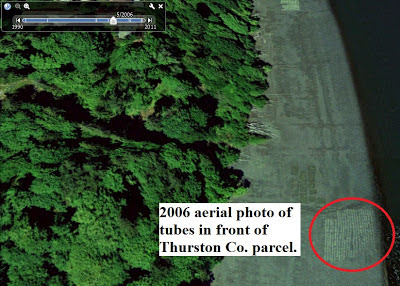Drakes Estero in California and Puget Sound in Washington have created a lens to look through when one wants to see how an industry uses selective science to achieve use of a resource which has multiple uses, some in conflict with what that industry wants. While focus has been on the oil industry's use of Drakes Bay Oyster Company (DBOC) as a pawn to open up other wilderness areas for drilling, an equally if not more important issue is hidden behind the fog- the shellfish industry's duplicity in determining what it defines as "science."
In the case of Drakes Estero the National Parks Service (NPS) initiated a number of studies to help understand whether DBOC's commercial use of Drakes Estero's waters and tidelands could exist within a designated wilderness area, the first shoreline wilderness area on the west coast. Those studies looked at the structures in the marine waters/tidelands, the non-native species of shellfish being grown, eelgrass beds, and noise. In part they helped to confirm that commercial operations, of any sort, within a designated wilderness area were simply not compatible. But to the shellfish industry what those studies revealed was alarming, setting off a cascade of legal actions and studies to prevent what the Executive Director of the East Coast Shellfish Growers Associate, Bob Rheault, defined as information which "will be used against our industry for decades to come".
It should be noted that Kevin Lunny, the owner of DBOC is also a cousin of ECSGA's past president, Tom Kehoe, and was also an active member in the Pacific Coast Shellfish Grower's Association (PCSGA). Both are industry's lobbying groups.
Brought into the picture was attorney Billy Plauche from Seattle and Environ International, an environmental consulting firm. Both are used by PCSGA to press agencies for the expansion of the shellfish industry in Washington. Challenges on the "quality of science" and counter-studies challenging the use of "proxies" (something similar to an action to determine whether the actual action is having an impact) were presented in an effort to prevent the information found from spreading to Washington where it may be used as a deterrent to expansion.
In November of 2012, Secretary Salazar made a decision. DBOC's commercial operation prevented the formation of the Congressionally designated wilderness area and the lease would not be renewed. It was a simple contractual decision based on the reality that were DBOC allowed to continue its operations, covering over 1,000 acres of the shoreline wilderness area, there would be nothing to stop other industries - oil, mining, timber - from saying their commercial operations should also be allowed into designated wilderness areas owned by the Federal Government - US taxpayers.
Puget Sound's tidelands are a mosaic of private and state owned parcels. Overseeing their development is the Shoreline Management Act, passed in 1971 when an attempt to convert the last large river delta area into a deep sea port was made. It acknowledges the multiple uses of the "most valuable and fragile of its natural resources" and that it should be managed to "minimize, insofar as practical, any resultant damage to the ecology and environment of the shoreline area and any interference with the public's use of the water." Through the SMA regulations have evolved which have prevented Puget Sound from becoming Chesapeake Bay.
As regulations have evolved, so has the shellfish industry. In the mid to late 1900's the industry could be relied on for ensuring the marine waters of Washington remained healthy. From the elimination of pulp mill effluent discharges in Shelton to forcing septic plants in Aberdeen to be upgraded so discharges into Grays Harbor were minimized, they were on the forefront. But in the 1990's what had been an industry made up of small family owned operations transitioned. Consolidation began to occur and control of the market began to fall into the hands of a few large companies. And the geoduck industry began to evolve.
What had been a subtidal operation run by the state and tribes, moved into the intertidal area, a strip of tidelands exposed and covered each day. An area where species unique to the world evolved and were able to survive both in and out of the marine waters. An area where geoducks were never able to establish themselves due to the natural ecosystem preventing their establishment. An area where placement of PVC pipes and netting created an artificial environment which allowed geoduck to be planted and harvested, creating a cycle of impacts which forever converted that area.
Alarmed by the ever increasing forests of PVC pipes appearing, in 2007 citizens demanded that the state act to ensure the Shoreline Management Act's goals were achieved. A bill was passed forcing review of science which showed none existed. The shellfish industry's famous response was "there is no science showing harm, therefor, there is no harm." Ignored was the fact that none existed, but because of citizen action, studies were initiated.
Included in the law was: RCW 28B.20.475 (3)
All research commissioned under this section must be subjected to a rigorous peer review process prior to being accepted and reported by the sea grant program. Since that time studies have taken place looking at discrete moments in time of a larger cycle.
What has not taken place is the peer review of those studies. Instead, during various permit applications a Masters Thesis is presented as "science" and the lead investigator's updates and presentations to PCSGA are used as "science." Environ's Biological Evaluations, authored by principals who themselves own geoduck companies, are presented as objective evaluations of whether there is an impact from geoduck farming. In short, the very "quality of science" problem the industry is so "alarmed" over in Drakes Estero is taking place in Puget Sound. The difference? Their "science" is somehow different.
The more noise made preventing Drakes Estero from becoming the wilderness Congress intended it to become, the more clear the duplicity found in the shellfish industry's use of selective science will become.


























